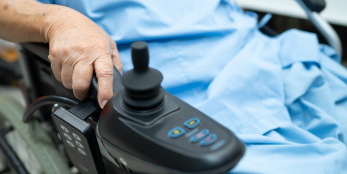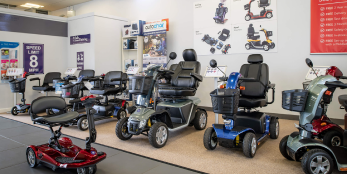Table of contents
Mobility Scooter Maintenance 101: Essential Tips for Longevity and Performance
Mobility scooters provide a lifeline to independence and freedom for individuals with limited mobility. Like any piece of equipment, they require regular care and attention to function at their best. Proper maintenance not only ensures peak performance but also extends the life of your scooter, keeping you safe and mobile for years to come. In this guide, we’ll cover everything you need to know to keep your mobility scooter running smoothly.
Why Mobility Scooter Maintenance Matters
Whether you use your mobility scooter daily or just on occasion, routine maintenance is critical. Here's a deeper look at why consistent care is so essential:
Safety: Your safety is the top priority. A well-maintained scooter is less likely to experience mechanical failures such as brake malfunctions, loose parts, or electrical issues that could result in accidents or injuries. Regular maintenance ensures all components are functioning as intended, providing you with peace of mind during every ride.
Reliability: There's nothing more frustrating than a scooter that won’t start when you need it. Routine upkeep—such as checking tire pressure, battery charge, and connection integrity—helps your scooter remain dependable. This reliability is crucial for those who rely on their scooters for daily tasks like errands, appointments, or social activities.
Cost Savings: Small maintenance tasks now can prevent major expenses later. For example, replacing worn tires or tightening a loose bolt is far more affordable than fixing damage caused by neglect. Taking a proactive approach helps you avoid unexpected repair bills and extends the overall lifespan of the scooter.
Resale Value: Thinking about upgrading in the future? A clean, well-functioning scooter with documented maintenance is much more attractive to buyers or trade-in evaluators. Regular care helps preserve your investment and gives you more options when it’s time for a new model.
Taking a little time each week or month to check on your mobility scooter is a simple yet powerful habit that leads to safer rides, fewer disruptions, and greater long-term satisfaction.

Daily and Weekly Maintenance Tips
-
Inspect the Tires
Check tire pressure (for pneumatic tires) and look for signs of wear or cracking.
Keep tires properly inflated to ensure smooth handling and reduce battery drain.
-
Clean the Scooter
Wipe down your scooter regularly to remove dust, dirt, and debris.
Avoid using a hose or submerging the scooter; use a damp cloth and mild detergent instead.
-
Check the Battery Level
Charge the battery after each use or as recommended by the manufacturer.
Avoid letting the battery fully discharge, as this can reduce its lifespan.
-
Test the Brakes
Before each ride, ensure the brakes are responsive and not making unusual noises.
Have any concerns checked by a professional.
-
Monitor Steering and Controls
Make sure the tiller or handlebars turn smoothly.
Confirm that all buttons, levers, and lights are functioning correctly.
Monthly Maintenance Tasks
-
Inspect the Battery and Connections
-
Look for corrosion on terminals and clean with a dry cloth if needed.
-
Make sure cables are securely connected.
-
-
Check for Loose Bolts and Screws
-
Vibrations from use can cause hardware to loosen over time.
-
Tighten any components that feel wobbly or out of place.
-
-
Lubricate Moving Parts
-
Apply manufacturer-approved lubricant to hinges, axles, and other moving parts to reduce friction and wear.
-
-
Test the Lights and Horn
-
Confirm that headlights, taillights, indicators, and the horn are all working properly, especially if you ride in low-light conditions.
-
Seasonal and Annual Maintenance
-
Full Battery Check-Up
Have your battery load-tested at least once a year, particularly if you’ve noticed a decline in range or charging speed.
-
Professional Inspection
Take your scooter to a certified technician annually for a full inspection and tune-up.
They can identify issues you might miss and perform tasks like motor diagnostics and controller calibration.
-
Storage Preparation
If you’re storing your scooter for the winter, charge the battery fully and disconnect it.
Store in a dry, temperature-controlled space away from direct sunlight or freezing temperatures.
Battery Care and Best Practices
The battery is the heart of your mobility scooter. Proper battery maintenance is key to performance and longevity.
-
Charge Regularly:
Consistent charging is crucial to maintain battery health. Even if you're not using your mobility scooter every day, make it a habit to charge the battery regularly—ideally after each use. Allowing the battery to fully discharge repeatedly (a process called “deep discharging”) can reduce its overall lifespan.
Quick Tip: If your scooter will sit idle for an extended period, fully charge the battery first and then recharge it every couple of weeks to prevent it from going flat.
-
Use the Right Charger:
Not all chargers are created equal. Using the wrong charger can overcharge or undercharge your battery, both of which can cause long-term damage. To ensure safe and efficient charging, always use the charger that came with your scooter or one recommended by the manufacturer.
Why It Matters: Third-party chargers may not match your battery’s voltage and amperage requirements, leading to overheating, reduced battery life, or even safety hazards.
-
Keep It Cool:
Batteries perform best when stored and used in stable, moderate temperatures. Avoid leaving your scooter—or just the battery—in direct sunlight, extreme cold, or damp environments. Temperature extremes can cause battery components to break down more quickly.
Storage Tip: Store your mobility scooter indoors in a cool, dry place when not in use, especially during the winter or summer months.
-
Replace When Needed:
Even with excellent care, most mobility scooter batteries have a lifespan of 12 to 24 months, depending on usage and type. If you begin to notice signs like reduced travel range, slower acceleration, or significantly longer charging times, it may be time to consider a replacement.
Pro Tip: Refer to your scooter’s user manual for specific battery replacement guidelines and recommended brands or specifications.
Transport and Travel Tips for Mobility Scooters: How to Keep Your Scooter Safe On the Go
Whether you're taking a road trip, hopping on a plane, or storing your mobility scooter in the trunk of your car, knowing how to safely transport it is key. Improper handling can lead to unnecessary damage, lost parts, or safety issues once you arrive at your destination.
Below are essential mobility scooter transport and travel tips to help you protect your investment and travel with peace of mind.
1. Secure Your Scooter During Transit
One of the most important steps when transporting a mobility scooter—especially by car, van, or accessible transport vehicle—is properly securing it. An unsecured scooter can shift, tip over, or collide with other items in the vehicle during turns or sudden stops.
Tips for Securing Your Scooter:
Use ratchet straps or tie-downs to anchor the scooter to fixed points in your vehicle.
If using a lift or platform carrier, double-check that safety locks and straps are engaged.
Avoid placing loose items near the scooter that could cause scratches or damage in transit.
Bonus Tip: Use soft padding around contact points to prevent scuffing or denting, especially during long-distance travel.
2. Fold or Disassemble with Care
Many scooters are designed to be folded or disassembled for easier transport, but it’s important to follow the correct process to avoid damaging any components.
Best Practices When Folding or Disassembling Your Mobility Scooter:
Always consult the manufacturer’s instructions—especially if it's your first time disassembling the unit.
Remove detachable parts like the seat, battery, or armrests before folding.
Never force parts that don’t seem to move easily. Forcing components can lead to cracks, broken latches, or misalignment.
Use both hands and maintain steady pressure when folding to keep the frame balanced.
For folding mobility scooters, ensure that the unit locks into its folded position before lifting or moving it to avoid accidental unfolding.
3. Inspect Your Scooter After Traveling
After a flight, cruise, or long road trip, it’s always a good idea to perform a quick inspection of your scooter before using it again.
What to Check Post-Travel:
Look for scratches, loose parts, or missing hardware.
Inspect the battery connection and test the battery level.
Make sure the tires are inflated and roll smoothly.
Confirm that the tiller and seat are properly locked in place.
This step is especially important after air travel, as scooters are typically handled by airline staff and may be loaded and unloaded with less care than you’d prefer.
Bonus Travel Tips:
-
Label Your Scooter: Attach a luggage tag with your name and contact info in case it gets misplaced during air or cruise travel.
-
Carry Tools and Spare Parts: Keep basic tools and spare parts like fuses, screws, or an extra key in your travel bag.
-
Check Airline and Cruise Policies: Always verify your scooter meets size, weight, and battery type requirements before booking.
Common Signs Your Mobility Scooter Needs Service
-
Decreased battery life or power
-
Unusual noises from the motor or wheels
-
Jerky or uneven movement
-
Flickering or non-working lights
-
Difficulty turning or braking
If you notice any of these signs, it’s time to schedule a professional inspection.
What is the average lifespan of a mobility scooter?
Make the most of your investment—mobility scooters typically last around five years, and potentially longer with proper care and maintenance.
What is the most common problem with mobility scooters?
Battery issues are among the most common problems with mobility scooters. As batteries age, they may lose capacity, resulting in shorter travel ranges, trouble recognizing the charger, reduced performance, and difficulty holding a full charge.
Should I leave my mobility scooter plugged in all the time?
Recharge your scooter after each use, particularly if the battery level falls below 50%–70%. To preserve battery health, avoid overnight charging or keeping it plugged in for long periods once it’s fully charged.
ow to maintain a mobility scooter?
Proper mobility scooter maintenance involves routine cleaning, battery upkeep, and regular checks of the tires and brakes. Wipe the scooter down with a damp cloth, keeping it dry and free from excess moisture. Charge the battery consistently to maintain performance. Before each use, inspect the tire pressure and tread, and ensure the brakes are functioning properly.
Final Thoughts: Keep Your Scooter at Its Best
Proper mobility scooter maintenance isn’t just about extending the life of your equipment—it’s about protecting your independence and ensuring your safety. By staying on top of regular upkeep, you’ll enjoy better performance, fewer breakdowns, and greater peace of mind.
Whether you rely on your scooter for daily use or occasional outings, following these essential maintenance tips will help ensure it’s always ready to go when you are.
Remember: a well-maintained scooter is a dependable scooter. Invest the time in caring for your equipment, and it will continue to support your mobility and lifestyle for years to come.








